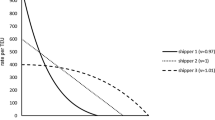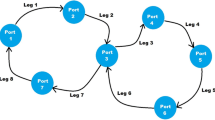Abstract
This paper discusses a variable pricing method, which is a special technique of revenue management, in the context of the competitive market of the liner shipping industry. Most papers on competitive variable pricing are based on two fundamental assumptions: (i) the length of a price-adjusting period is short enough so that in each period at most one customer can arrive; and (ii) the real-time inventory levels of all firms constitute public information. This paper relaxes both assumptions so that each interval between two consecutive freight rate changes allows more than one shipper to arrive and that a line knows only its competitors’ initial carrying capacity at the beginning of the sales process. A multi-iteration of genetic algorithm is proposed and numerically tested.






Similar content being viewed by others
References
Abrate, G., and G. Viglia. 2016. Strategic and tactical price decisions in hotel revenue management. Tourism Management 55: 123–132.
Arenoe, B., J.P.I.V.D. Rest, and P. Kattuman. 2015. Game theoretic pricing models in hotel revenue management: An equilibrium choice-based conjoint analysis approach. Tourism Management 51: 96–102.
Ben-Akiva, M., and S.R. Lerman. 1985. Discrete Choice Analysis: Theory and Application to Travel Demand. Cambridge MA: The MIT Press.
Boyd, E.A., and I.C. Bilegan. 2003. Revenue Management and E-Commerce. Management Science 49 (10): 1363–1386.
Chatwin, R.E. 2000. Optimal dynamic pricing of perishable products with stochastic demand and a finite set of prices. European Journal of Operational Research 125 (1): 149–174.
Chiang, W.C., J.C.H. Chen, and X. Xu. 2007. An overview of research on revenue management: Current issues and future research. International Journal of Revenue Management 1 (1): 97–128.
Feng, Y., and B. Xiao. 2000. A continuous-time yield management model with multiple prices and reversible price changes. Management Science 46 (5): 644–657.
Franses, P.H., and R. Paap. 2010. Quantitative Models in Marketing Research. Cambridge: Cambridge University Press.
Gallego, G., and M. Hu. 2014. Dynamic Pricing of Perishable Assets Under Competition. Management Science 60 (5): 1241–1259.
Grauberger, W., and A. Kimms. 2016. Revenue management under horizontal and vertical competition within airline alliances. Omega 59: 228–237.
Kinderlehrer, D., and G. Stampacchia. 1980. An Introduction to Variational Inequality and Their Application. New York: Academic Press.
Koupriouchina, L., J.P.V.D. Rest, and Z. Schwartz. 2014. On revenue management and the use of occupancy forecasting error measures. International Journal of Hospitality Management 41: 104–114.
Lee, L.H., E.P. Chew, and M.S. Sim. 2007. A heuristic to solve a sea cargo revenue management problem. OR Spectrum 29 (1): 123–136.
Lee, L.H., E.P. Chew, and M.S. Sim. 2009. A revenue management model for sea cargo. International Journal of Operational Research 6 (2): 195–222.
Lin, K.Y. 2004. A sequential dynamic pricing model and its applications. Naval Research Logistics 51 (4): 501–521.
Lina, K.Y., and S.Y. Sibdari. 2009. Dynamic price competition with discrete customer choices. European Journal of Operational Research 197 (3): 969–980.
Liu, D., and H.L. Yang. 2013. Optimal slot control model of container sea-rail intermodal transport based on revenue management. Procedia - Social and Behavioral Sciences 96: 1250–1259.
Liu, Q., and D. Zhang. 2013. Dynamic pricing competition with strategic customers under vertical product differentiation. Management Science 59 (1): 84–101.
Maragos, S.A. (1994) Yield Management for the Maritime Industry. PhD thesis, Massachusetts Institute of Technology, Massachusetts, USA.
Netessine, S., and R.A. Shumsky. 2005. Revenue management games: horizontal and vertical competition. Management Science 51 (5): 813–831.
Nagurney, A. 1999. Network Economics: A Variational Inequality Approach, 2nd ed. Boston: Kluwer Academic Press.
Nguyen, H.O., A. Chin, J. Tongzon, and M. Bandara. 2015. Analysis of strategic pricing in the port sector: The network approach. Maritime Economics & Logistics 25 (4): 210–216.
Ødegaard, F., and J.G. Wilson. 2016. Dynamic pricing of primary products and ancillary services. European Journal of Operational Research 251 (2): 586–599.
Sibdari, S., and D.F. Pyke. 2010. A competitive dynamic pricing model when demand is interdependent over time. European Journal of Operational Research 207 (1): 330–338.
Sierag, D.D., G.M. Koole, R.D.V.D. Mei, J.I.V.D. Rest, and B. Zwart. 2015. Revenue management under customer choice behaviour with cancellations and overbooking. European Journal of Operational Research 246 (1): 170–185.
Sim, M.S. (2005) A revenue management model for sea cargo. PhD thesis, National University of Singapore, Singapore.
Talluri, K., and G. Van Ryzin. 2004. Revenue management under a general discrete choice model of consumer behavior. Management Science 50 (1): 15–33.
Wang, Y., Q. Meng, and Y. Du. 2015. Liner container seasonal shipping revenue management. Transportation Research Part B: Methodology 82: 141–161.
Wei, Y., C. Xu, and Q. Hu. 2013. Transformation of optimization problems in revenue management, queueing system, and supply chain management. International Journal of Production Economics 146 (2): 588–597.
Wen, X., C. Xu, and Q. Hu. 2016. Dynamic capacity management with uncertain demand and dynamic price. International Journal of Production Economics 175: 121–131.
Zhao, W., and Y.S. Zheng. 2000. Optimal dynamic pricing for perishable assets with nonhomogeneous demand. Management Science 46 (3): 375–388.
Zhuang, W., and Z.F. Li. 2012. Dynamic pricing with two revenue streams. Operations Research Letters 40 (1): 46–51.
Zurheide, S., and K. Fischer. 2012. A revenue management slot allocation model for liner shipping networks. Maritime Economics & Logistics 14 (3): 334–361.
Acknowledgements
This study was sponsored by the National Natural Science Foundation of China for Youth Scholars (71402096), Social Science Foundation of Ministry of Education of China for Youth Scholars (14YJC630172), and Shanghai Pujiang Program (14PJC058). The authors thank MEL reviewers and editors for their valuable comments and kind help with the paper.
Author information
Authors and Affiliations
Corresponding author
Appendices
Appendix 1
According to Kinderlehrer and Stampacchia (1980) and Nagurney (1999), there is at least one solution to variational inequity: < F(Xb), X − Xb > ≥ 0, ∀Xb ∊ Φb, if Φb is closed, bounded, and convex, and F(X) is continuous.
For line i, the Lagrange function for optimization is
Its partial derivatives with respect to p ( t) i and γi are, respectively,
In (2),
The corresponding variational inequity can be expressed as
Therefore, to the game of this section, Φb = {p ( t)1 , …, p ( t) N ; γ1, …, γN}, and p ( t) i ∈[0, ζi] and γi∈[0, εi], where ζi ≥ 0 and εi ≥ 0, without a loss of generality.
Under this assumption, it is evident that Φb is closed, bounded, and convex. Based on (4), the vector function F(X) can be expressed as
From (5), it is evident that F(X) is continuous with respect to {p ( t)1 , …,p ( t) N ; γ1, …, γN}.
Overall, the variational equity derived from the game of this section complies with the conditions proven by Kinderlehrer and Stampacchia (1980) and Nagurney (1999). Hence, there is at least one pure-strategy Nash equilibrium in the game.
Appendix 2
- Step 1:
-
Let iter = 1 and set M, the maximum rounds of iteration, and/or the criteria of convergence.
- Step 2:
-
Set the initial value of vectors P (t)*2 , P (t)*3 , …, P (t)* N , t = 1,…, D, e.g., (1 1 1 … 1)1×D.
- Step 3:
-
With P ( t)*2 , P ( t)*3 , …, P ( t)* N , calculate line 1’s optimal revenue Π *1 and the corresponding P ( t) *1 for t = 1,…, D by the GA described later.
- Step 4:
-
With P ( t)*1 , P ( t)*3 , …, P ( t)* N , calculate line 2’s optimal revenue Π *2 and the corresponding P ( t) *2 for t = 1,…, D by the GA.
…
- Step N + 2:
-
With P ( t)*1 , P ( t)*2 , …, P ( t)* N- 1 , calculate line N’s optimal revenue Π * N and the corresponding P (t)* N for t = 1,…, D by the GA.
- Step N + 3:
-
iter = iter + 1.
- Step N + 4:
-
Return to Step 3, unless iter > M, and/or the criteria of convergence are met.
- Step N + 5:
-
Output every line i’s optimal profit Π * i and their corresponding p ( t) * i , and end the procedure.
Appendix 3
- Step 1:
-
Generate the initial population for Pi = (p (1) i , p (2) i , …, p ( D) i ), and let gen = 1.
- Step 2:
-
Decode all groups of chromosomes in the current population and calculate their corresponding revenue Πi.
- Step 3:
-
gen = gen + 1. If gen exceeds the maximum number of generations, then go to Step 4. Otherwise, generate the population for the next generation:
- Step 3.1:
-
Select a pre-specified percentage, normally known as the “generation gap,” of chromosomes from the population of previous generations with the best fitness values, and remove the other chromosomes.
- Step 3.2:
-
Apply the crossover operator to the chromosomes selected in Step 3.1 randomly but at a certain percentage.
- Step 3.3:
-
Apply the mutation operator to the chromosomes obtained in Step 3.2 randomly but at a certain percentage.
- Step 3.4:
-
Select the offspring chromosomes from those obtained in Step 3.3 with the best fitness values at a certain percentage. Replace the worst chromosomes in the population of the previous generation with the newly selected chromosomes and go to Step 2.
- Step 4:
-
Let line i’’s optimal revenue Π * i = max(Πi), and its corresponding P * i = (p (1) i , p (2) i , …, p ( D) i ). Return this result and stop.
Rights and permissions
About this article
Cite this article
Yin, M., Wan, Z., Kim, K.H. et al. An optimal variable pricing model for container line revenue management systems. Marit Econ Logist 21, 173–191 (2019). https://doi.org/10.1057/s41278-017-0082-8
Published:
Issue Date:
DOI: https://doi.org/10.1057/s41278-017-0082-8




